Tablet Citroen C4 PICASSO 2016 2.G User Guide
[x] Cancel search | Manufacturer: CITROEN, Model Year: 2016, Model line: C4 PICASSO, Model: Citroen C4 PICASSO 2016 2.GPages: 527, PDF Size: 13.72 MB
Page 66 of 527
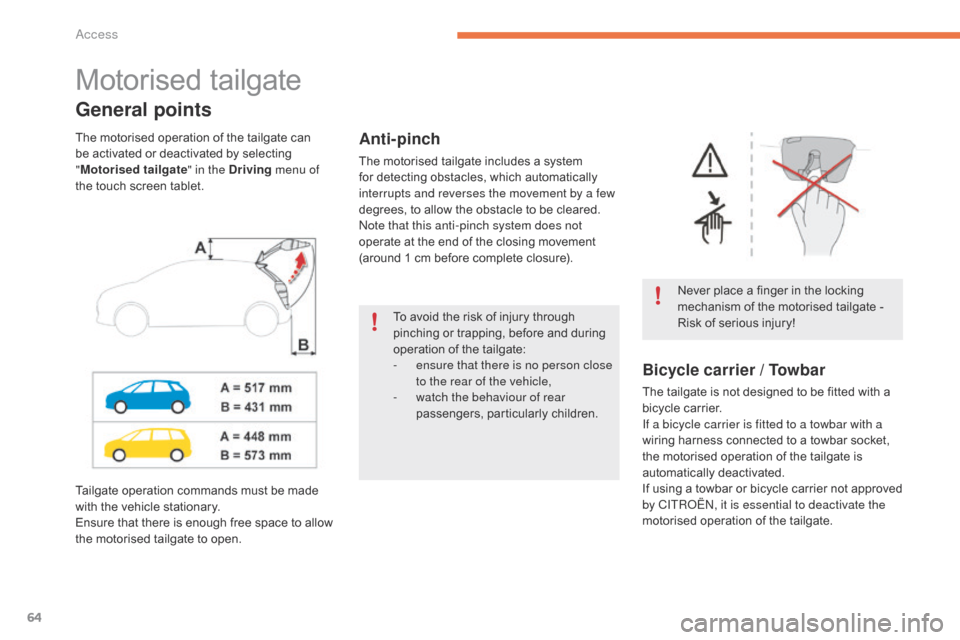
64
C4-Picasso-II_en_Chap02_ouvertures_ed01-2016
Motorised tailgate
General points
Never place a finger in the locking mechanism of the motorised tailgate -
R
isk of serious injury!
Anti-pinch
The motorised tailgate includes a system for detecting obstacles, which automatically
i
nterrupts and reverses the movement by a few
degrees,
to allow the obstacle to be cleared.
Note that this anti-pinch system does not
operate
at the end of the closing movement
(
around 1 cm before complete closure).
The
motorised
operation
of
the
tailgate
can
b
e
activated
or
deactivated
by
selecting
"
M
otorised tailgate " in the Driving menu of
the
touch
screen
tablet.
Bicycle carrier / Towbar
The tailgate is not designed to be fitted with a b icycle carrier.
If a bicycle carrier is fitted to a towbar with a
wiring
harness connected to a towbar socket,
t
he motorised operation of the tailgate is
a
utomatically
d
eactivated.
If
using a towbar or bicycle carrier not approved
b
y CITROËN, it is essential to deactivate the
motorised
operation of the tailgate.
Tailgate
operation
commands
must
be
made
w
ith
the
vehicle
stationary.
Ensure
that
there
is
enough
free
space
to
allow
t
he
motorised
tailgate
to
open. To
avoid
the
risk
of
injury
through
p
inching
or
trapping,
before
and
during
o
peration
of
the
tailgate:
-
e
nsure that there is no person close
to the rear of the vehicle,
-
w
atch the behaviour of rear
passengers,
par
ticularly
c
hildren.
Access
Page 70 of 527
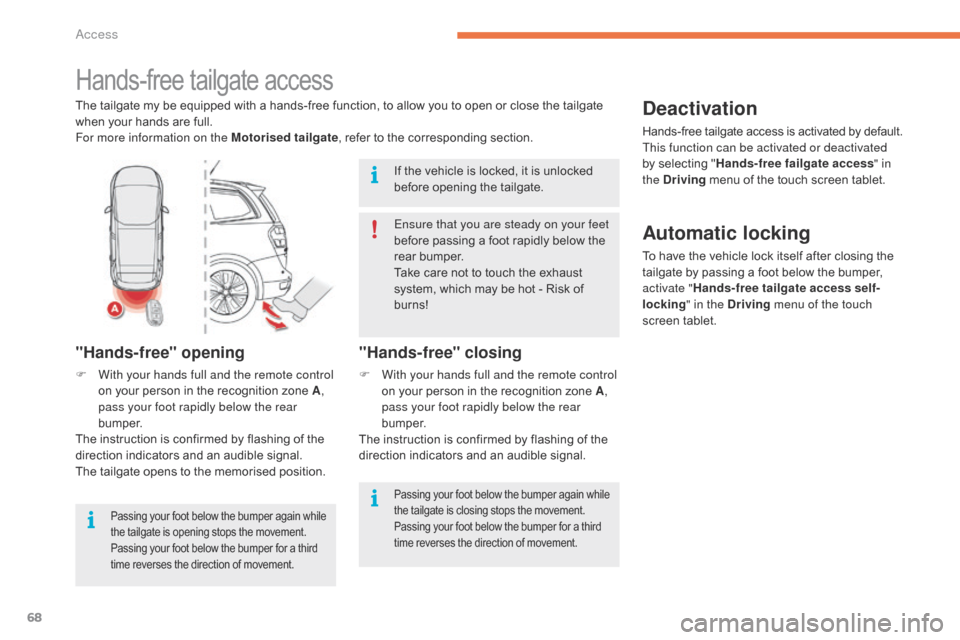
68
C4-Picasso-II_en_Chap02_ouvertures_ed01-2016
Hands-free tailgate access
The tailgate my be equipped with a hands-free function, to allow you to open or close the tailgate when your hands are full.
For more information on the Motorised tailgate ,
refer to the corresponding section.
"Hands-free" opening
F With your hands full and the remote control on your person in the recognition zone A,
pass your foot rapidly below the rear
b u m p e r.
The
instruction is confirmed by flashing of the
d
irection indicators and an audible signal.
The
tailgate opens to the memorised position.
Passing your foot below the bumper again while the tailgate is opening stops the movement. P
assing your foot below the bumper for a third
t
ime reverses the direction of movement.
"Hands-free" closing
F With your hands full and the remote control on your person in the recognition zone A,
pass your foot rapidly below the rear
b u m p e r.
The
instruction is confirmed by flashing of the
d
irection indicators and an audible signal.
Deactivation
Hands-free tailgate access is activated by default.
T his function can be activated or deactivated
by
selecting "Hands-free failgate access " in
the Driving
menu of the touch screen tablet.
Ensure that you are steady on your feet
before
passing
a
foot
rapidly
below
the
r
ear
bumper.
Take
care
not
to
touch
the
exhaust
s
ystem,
which
may
be
hot
-
Risk
of
b
urns!
If
the
vehicle
is
locked,
it
is
unlocked
b
efore
opening
the
tailgate.
Automatic locking
To have the vehicle lock itself after closing the t ailgate by passing a foot below the bumper,
a
ctivate " Hands-free tailgate access self-
locking " in the Driving menu of the touch
screen
t
ablet.
Passing your foot below the bumper again while the tailgate is closing stops the movement. P
assing your foot below the bumper for a third
t
ime reverses the direction of movement.
Access
Page 94 of 527
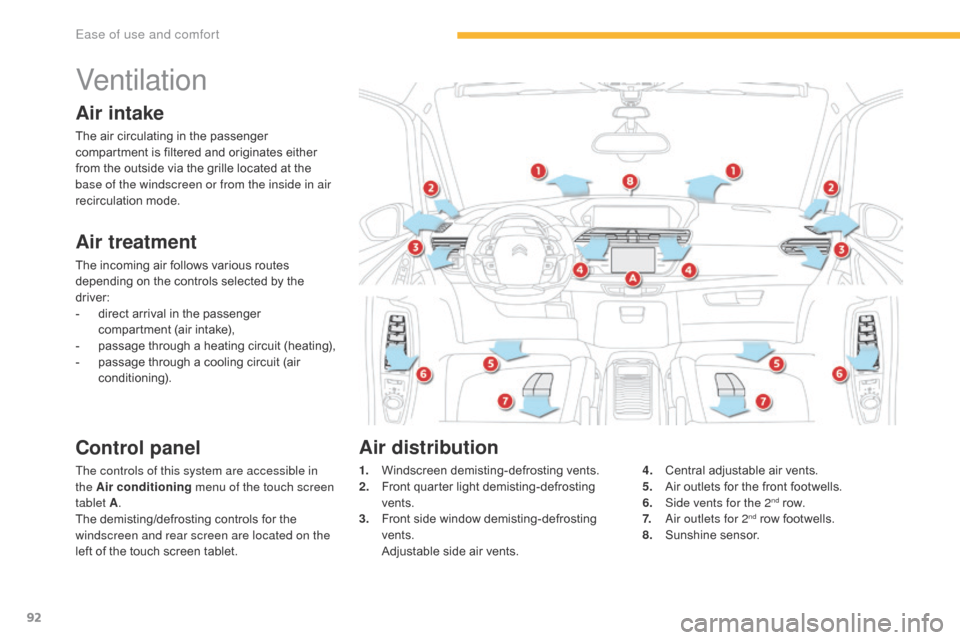
92
C4-Picasso-II_en_Chap03_ergonomie-confort_ed01-2016
Ventilation
Air intake
The air circulating in the passenger compartment is filtered and originates either
f
rom the outside via the grille located at the
b
ase of the windscreen or from the inside in air
recirculation
m
ode.
Air treatment
The incoming air follows various routes depending on the controls selected by the
d
river:
-
d
irect arrival in the passenger
c
ompartment (air intake),
-
p
assage through a heating circuit (heating),
-
p
assage through a cooling circuit (air
c
onditioning).
Control panel
The controls of this system are accessible in
the Air conditioning menu of the touch screen
tablet A .
The
demisting/defrosting controls for the
w
indscreen and rear screen are located on the
left
of the touch screen tablet. 1. W
indscreen d emisting-defrosting v ents.
2. F ront quarter light demisting-defrosting
ve
nts.
3.
F
ront side window demisting-defrosting
ve
nts.
A
djustable side air vents.4. C
entral adjustable air vents.
5. A ir outlets for the front footwells.
6.
S
ide vents for the 2
nd row.
7. A
ir outlets for 2nd row footwells.
8. S
unshine s
ensor.
Air distribution
Ease of use and comfort
Page 111 of 527

109
C4-Picasso-II_en_Chap03_ergonomie-confort_ed01-2016
When the USB port is used, the
portable device charges automatically.
A
message is displayed if the power
c
onsumption of the portable device
exceeds
the current supplied by the
v
ehicle.
12 V socket
The auxiliary socket is located in the central s torage box.
It permits the connection of a portable device,
such
as a digital audio player of the iPod
® type,
to
listen
to
your
music
files
using
the
vehicle's
s
peakers.
The
management
of
the
files
is
done
using your
p
ortable
d
evice. The
USB port is located in the central storage
c
ompartment.
It allows the connection of a portable device or
a USB memory stick.
It plays the audio files transmitted to your audio
system
and heard via the vehicle's speakers.
You
can manage these files using the steering
m
ounted or touch screen tablet controls.
Auxiliary socketUSB port
For more information on the use of this
equipment, refer to the "Audio and telematics"
supplement.
F
T
o
connect
a
12
V
accessory
(maximum
p
ower:
120
Watts),
lift
the
cover
and
c
onnect
a
suitable
adaptor.
Do
not
exceed
the
maximum
power
r
ating
of
the
socket
(other wise
there
is
a
r
isk
of
damaging
your
portable
device).
The connection of an electrical device
not approved by CITROËN, such as a
USB
charger,
may
adversely
affect
the
o
peration of vehicle electrical systems,
causing
faults
such
as
poor
telephone
r
eception or inter ference with displays
in
the
screens.
3
Ease of use and comfort
Page 149 of 527

147
C4-Picasso-II_en_Chap04_conduite_ed01-2016
Going into engine START mode
This indicator lamp goes off and the engine s tarts a utomatically:
-
w
ith a manual gearbox , when you fully
depress the clutch pedal,
-
w
ith an automatic gearbox :
●
g
ear selector in position D or M, when
you
release the brake pedal,
●
o
r
gear selector in position N and brake
p
edal released, when you place the gear
s
elector in position D or M ,
●
o
r
when you engage reverse. START
mode is invoked automatically when:
- y ou open the driver's door,
-
y
ou unfasten the driver's seat belt,
-
t
he speed of the vehicle exceeds 15 mph
(
25 km/h) with a manual gearbox (2 mph
(
3 km/h) with PureTech 130, THP 165 and
B
lueHDi 100, 115 and 120 versions) and
2 mph
(3 km/h) with an automatic gearbox,
-
t
he electric parking brake is being applied,
-
s
ome special conditions (battery charge,
e
ngine temperature, braking assistance,
a
mbient temperature...) where the engine is
n
eeded for control of a system.
Special cases: START invoked
automaticallyIn some circumstances, such as the need to
maintain a comfortable temperature in the
passenger compartment, it may be necessary
t
o deactivate the Stop & Start system.
The system can be deactivated at any time,
once
the ignition is on.
If
the engine is in STOP mode, it then restarts.
The Stop & Start system is automatically
reactivated
every time the ignition is
s
witched on.
Manual deactivation/
reactivation
In this case this indicator lamp flashes
for a few seconds, then goes off.
This operation is perfectly normal. Select
"Stop & Start" to deactivate the system.
This is confirmed by the illumination
of this indicator lamp.
Using the dynamic cruise control
d
eactivates the Stop & Start system.
Deactivation of Stop & Start is done in the
Driving
menu of the touch screen tablet.
Select "Stop & Start" again to reactivate the
s
ystem.
This is confirmed by the illumination
of this indicator lamp.
4
Driving
Page 151 of 527

149
C4-Picasso-II_en_Chap04_conduite_ed01-2016
Memorising speeds
Memorising
This function allows speeds to be saved, which can then be offered to set the two systems: the speed limiter (to limit the speed of the vehicle) or the c
ruise control (for a vehicle cruising speed).
You
can memorise up to six speed settings for each of the two systems. By default, some speed settings are already memorised.
F
S
elect the system for which you want to
memorise
new speed settings.
This function is accessible in the Driving
menu
of
the touch screen tablet.
F
Sel
ect the " Driving assistance " tab, then
Speed settings .
F
P
ress the button corresponding to the
s
peed setting you want to modify.
As a safety measure, the driver must
carry out these operations when
stationary.
F
E
nter the new value using the numerical
k
eypad and confirm.
4
Driving
Page 153 of 527
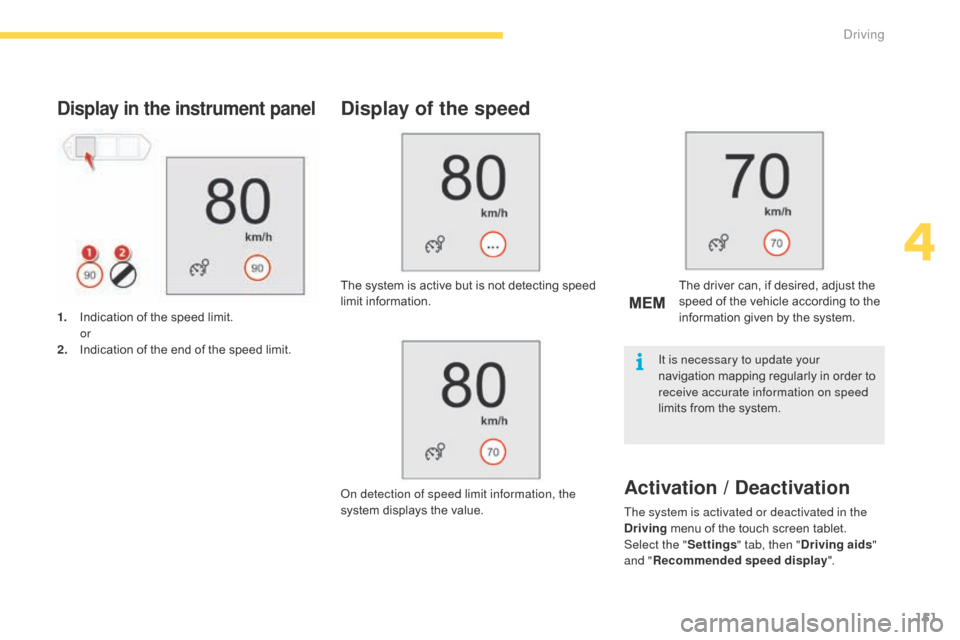
151
C4-Picasso-II_en_Chap04_conduite_ed01-2016
Display in the instrument panel
1. Indication of the speed limit.
or
2.
I
ndication of the end of the speed limit.
Display of the speed
The system is active but is not detecting speed limit in formation.
On detection of speed limit information, the
system
displays the value. The
driver can, if desired, adjust the s
peed of the vehicle according to the
i
nformation given by the system.
The system is activated or deactivated in the
Driving
menu of the touch screen tablet.
Select the " Settings" tab, then " Driving aids "
and " Recommended speed display ".
Activation / Deactivation
It is necessary to update your
navigation
mapping regularly in order to
r
eceive accurate information on speed
limits
from the system.
4
Driving
Page 157 of 527
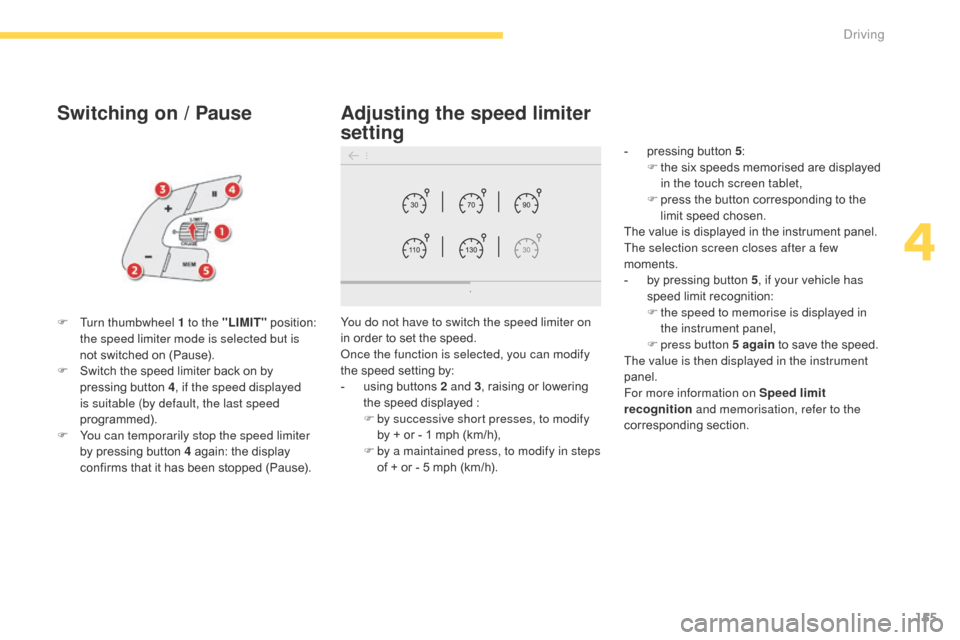
155
C4-Picasso-II_en_Chap04_conduite_ed01-2016
Switching on / Pause
F Turn thumbwheel 1 to the "LIMIT" position: t
he speed limiter mode is selected but is
not
switched on (Pause).
F
S
witch the speed limiter back on by
p
ressing button 4, if the speed displayed
is suitable (by default, the last speed
programmed).
F
Y
ou can temporarily stop the speed limiter
by
pressing button 4 again: the display
c
onfirms that it has been stopped (Pause).You do not have to switch the speed limiter on
in
order to set the speed.
Once the function is selected, you can modify
the
speed setting by:
-
u
sing buttons 2 and 3,
raising or lowering
t
he speed displayed :
F
b
y successive short presses, to modify
by
+ or - 1 mph (km/h),
F
b
y a maintained press, to modify in steps
of
+ or - 5 mph (km/h).
Adjusting the speed limiter
setting
- pressing button 5:
F t he six speeds memorised are displayed
i
n the touch screen tablet,
F
p
ress the button corresponding to the
l
imit speed chosen.
The
value is displayed in the instrument panel.
The selection screen closes after a few
moments.
-
b
y pressing button 5, if your vehicle has
speed
limit recognition:
F
t
he speed to memorise is displayed in
the instrument panel,
F
press button 5 again
to save the speed.
The value is then displayed in the instrument
panel.
For more information on Speed limit
recognition and memorisation, refer to the
corresponding
s
ection.
4
Driving
Page 160 of 527
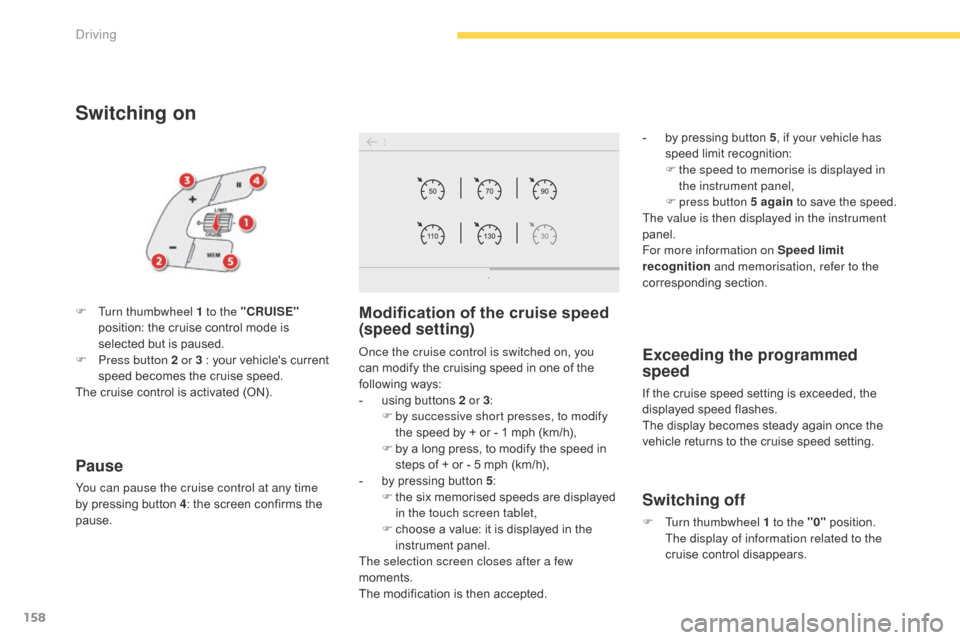
158
C4-Picasso-II_en_Chap04_conduite_ed01-2016
Exceeding the programmed
speed
If the cruise speed setting is exceeded, the displayed speed flashes.
The
display becomes steady again once the
v
ehicle returns to the cruise speed setting.
Switching off
F Turn thumbwheel 1 to the "0" p osition. T
he display of information related to the
cruise
control disappears.
Switching on
Once the cruise control is switched on, you
can modify the cruising speed in one of the
f
ollowing
w
ays:
-
u
sing buttons 2 or 3:
F
b
y successive short presses, to modify
the
speed by + or - 1 mph (km/h),
F
b
y a long press, to modify the speed in
s
teps of + or - 5 mph (km/h),
-
b
y pressing button 5:
F
t
he six memorised speeds are displayed
i
n the touch screen tablet,
F
c
hoose a value: it is displayed in the
in
strument
pan
el.
The selection screen closes after a few
moments.
The
modification is then accepted.
F
T
urn thumbwheel 1 to the "CRUISE"
position:
the
cruise
control
mode
is
s
elected
but
is
paused.
F
P
ress button 2 or 3 :
your
vehicle's
current
s
peed
becomes
the
cruise
speed.
The
cruise
control
is
activated
(ON).
Modification of the cruise speed
(speed setting)
- by pressing button 5, if your vehicle has
speed limit recognition:
F
t
he speed to memorise is displayed in
the instrument panel,
F
press button 5 again
to save the speed.
The value is then displayed in the instrument
panel.
For more information on Speed limit
recognition and memorisation, refer to the
corresponding
s
ection.
Pause
You can pause the cruise control at any time
by pressing button 4:
the screen confirms the
pa
use.
Driving
Page 164 of 527
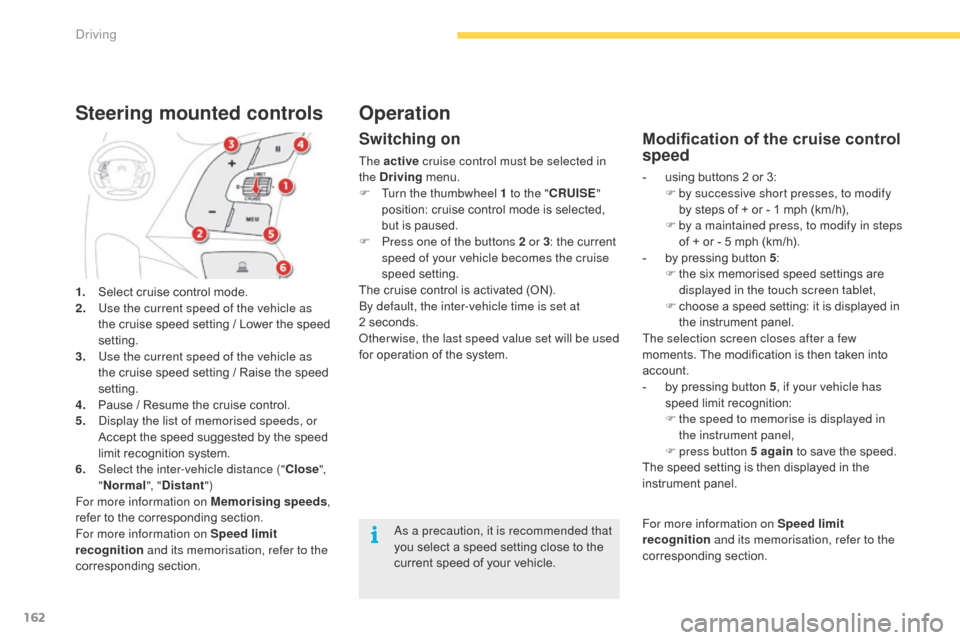
162
C4-Picasso-II_en_Chap04_conduite_ed01-2016
1. Select cruise control mode.
2. U se the current speed of the vehicle as
the
cruise speed setting / Lower the speed
se
tting.
3.
U
se the current speed of the vehicle as
the
cruise speed setting / Raise the speed
se
tting.
4.
P
ause / Resume the cruise control.
5.
D
isplay the list of memorised speeds, or
A
ccept the speed suggested by the speed
l
imit recognition system.
6.
S
elect the inter-vehicle distance (" Close",
" Normal ", "Distant ")
For more information on Memorising speeds ,
refer
to the corresponding section.
For more information on Speed limit
recognition and its memorisation, refer to the
corresponding
s
ection.
Steering mounted controls
Switching on
The active cruise control must be selected in
the Driving menu.
F
T
urn the thumbwheel 1 to the " CRUISE"
position:
cruise control mode is selected,
b
ut is paused.
F
P
ress one of the buttons 2 or 3 :
the current
s
peed of your vehicle becomes the cruise
speed
setting.
The
cruise control is activated (ON).
By default, the inter-vehicle time is set at
2 seconds.
Other wise, the last speed value set will be used
for
operation of the system.
Modification of the cruise control
speed
- using buttons 2 or 3:
F b y successive short presses, to modify
by
steps of + or - 1 mph (km/h),
F
b
y a maintained press, to modify in steps
of
+ or - 5 mph (km/h).
-
b
y pressing button 5:
F
t
he six memorised speed settings are
d
isplayed in the touch screen tablet,
F
c
hoose a speed setting: it is displayed in
t
he instrument panel.
The selection screen closes after a few
moments.
The modification is then taken into
a
ccount.
-
b
y pressing button 5, if your vehicle has
speed
limit recognition:
F
t
he speed to memorise is displayed in
the instrument panel,
F
press button 5 again
to save the speed.
The
speed setting is then displayed in the
in
strument
pan
el.
As a precaution, it is recommended that
you
select
a
speed
setting
close
to
the
c
urrent
speed
of
your
vehicle.
Operation
For more information on Speed limit
recognition and its memorisation, refer to the
corresponding
s
ection.
Driving